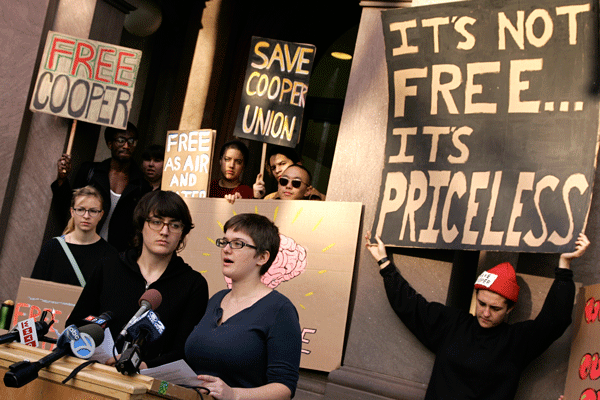BY ZACH WILLIAMS | The costs of implementing tuition at The Cooper Union have included an increasingly chilly relationship between the college administration and the school’s alumni association. But a bit of a thaw began last week between the two sides.
A 40-year-old relationship between the Cooper Union Alumni Association and the college will effectively end, following a Nov. 21 agreement under which the association will become an independent nonprofit responsible for its own funding.
Despite the split, representatives of the alumni association, the administration and board of trustees expressed optimism after a Nov. 18 meeting that relations among them would improve following the agreement.
Much remains up in the air as the larger college community awaits a State Supreme Court decision on a lawsuit challenging the legality of charging tuition at the school. But for now, CUAA can focus once again on its primary mission of engaging alumni, according to Karina Tipton, chairperson of the association’s communications committee.
“I won’t say this is a return to normalcy, but it has freed us up to continue to move forward,” she said.
In a Nov. 21 joint statement, the representatives said that CUAA could resume using alumni e-mail lists as well as campus meeting space after being denied use of such resources by the administration for months. CUAA and the campus Office of Alumni Affairs will also launch separate Web sites, though they will consider cooperating in the future on a case-by-case basis, according to the statement.
Discussions will continue at a meeting scheduled for Dec. 4. Among the topics will be revising a 1974 memorandum of agreement, according to the statement. CUAA is responsible for alumni outreach as the official representative of all formerly matriculated students at the 155-year-old East Village institution, according to the memo.
That duty will now likely change as discussion among CUAA, the administration and trustees continues.
By agreeing to the memorandum four decades ago, the college assumed the costs of administrative support for the previously independent CUAA, which would represent the interests of alumni now estimated at about 12,000 people worldwide. But as the years passed, these costs grew, as did disagreements between CUAA and administrators on how to engage alumni amid the school’s financial difficulties, according to Justin Harmon, the college’s spokesperson.
“While both sides agree on the primary purpose of their activity — to engage alumni,” Harmon said, “honest disagreements have ensued over the best use of scarce resources, particularly where institutional budgets and the allocation of staff time are concerned.”
For CUAA such differences eventually meant losing access to the online resources, as well as an effective ban from campus since the new semester began.
According to alumnus Barry Drogin, a prominent critic of the Cooper Union administration, such moves were part of a general campaign by the administration to discourage criticism of its handling of college finances.
“The administration has been in violation of the memorandum between CUAA and the college and has launched a war against the alumni that includes censorship, propaganda and denial of services,” Drogin said.
The administration has also strengthened its own Office of Alumni Affairs, which has organized its own outreach events in recent months, according to Harmon. While both CUAA and the school administration pledged cooperation moving forward, the campus Office of Alumni Affairs will continue extending its own outreach, according to the joint statement.
“Regardless of the role played by CUAA, we will redouble our efforts to develop events and programs that encourage alumni to participate actively in the life of the institution,” Harmon said.
But the battle over the hearts, minds and pocketbooks of alumni has taken its toll, as has the ongoing litigation, the spokesperson acknowledged.
“The lawsuit has led to a tremendous amount of misinformation, which in turn has caused some alumni to question their financial commitment to Cooper,” he said.
Critics meanwhile allege that something more profound is at stake for students, alumni and the East Village community if Cooper Union continues as a tuition-funded college.
“If Cooper Union becomes just another corporate moneymaking education venture, it’s going to lose its role, its agency and its primacy as an actual center for culture and intellectual conversation,” said alumnus Ben Degen.
Degen moderated a Nov. 13 panel discussion in Brooklyn accompanying a screening of the documentary “Ivory Tower,” which uses Cooper Union as one example of the purported corporatization of American higher education. This trend has for years fueled the friction between CUAA and the administration, Drogin wrote on Nov. 22 in a 3,000-word history of the alumni association that he posted on his blog.
Relations deteriorated after the 2011 appointment of Jamshed Bharucha as Cooper’s president, according to Drogin. As anti-tuition sentiment grew within CUAA — including the 2013 write-in election of alumni trustee Kevin Slavin — the rift with the administration widened, he said.
Drogin argued that ongoing financial support for the Committee to Save Cooper Union — the plaintiff in the ongoing lawsuit — demonstrates how alumni sentiment remains firmly anti-tuition and, thus, anti-administration, as well.
“Despite the ‘embargo’ and temporary loss of direct communications between the CUAA Council and alumni, the Committee to Save Cooper Union raised over $300,000 before the joint statement was issued, most of that from alumni,” Drogin said.


















